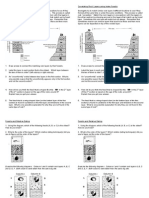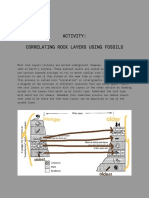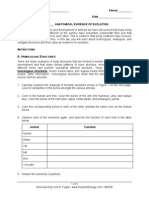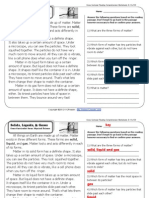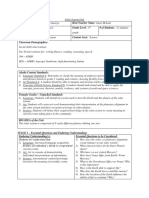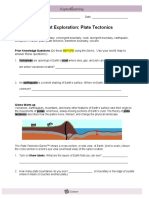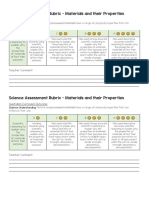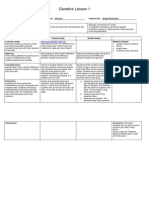Relative Dating Booklet Key
Relative Dating Booklet Key
Uploaded by
かな どなりCopyright:
Available Formats
Relative Dating Booklet Key
Relative Dating Booklet Key
Uploaded by
かな どなりOriginal Title
Copyright
Available Formats
Share this document
Did you find this document useful?
Is this content inappropriate?
Copyright:
Available Formats
Relative Dating Booklet Key
Relative Dating Booklet Key
Uploaded by
かな どなりCopyright:
Available Formats
Name: _______________________________ Date: _________________ Block: _______
Relative Dating
You are an expert in relative dating techniques. You need to explain, using the chart below, the
relative age of the fossils in relationship to the other fossils. Answer each question. Once you have all
of your answers recorded, WRITE YOUR PARAGRAPH RESPONSE in your NOTEBOOK.
1) Using the letters printed on the left, what is the
order of the rock layers from youngest to oldest?
O-R-G-A-N-I-S-M
2) What is the youngest fossil? How do you know?
The youngest fossil is the Foraminniferan. I know this
because it is in Layer O, the youngest layer at the top.
3) What is the oldest fossil? How do you know?
The oldest fossil is the Tribrachidium. I know this
because it is in layer M, the oldest layer at the bottom.
4) An index fossil is a fossil that is found only in one
layer of earth and can be used to date layers.
What fossils would be good index fossils? Explain
why.
The Foraminniferan would be a good index fossil
because it shows only in layer O at the top.
5) What fossils would be bad index fossils? Explain
why.
Some bad index fossils would be the Brachiopod,
Diplomytus, Crinoid, and Trilobite fossils because they
occur in more than one level. This would not accurately
indicate the age of a fossil solely based on its location in
the rock strata.
Name: ____________________________ Period ______
Principles of Geology:
Law of Uniformitarianism: The way things occurred in the past are likely the same way things occur today.
(example: rivers flow downhill today so they probably flowed downhill in the past also)
Law of Superposition: The youngest layer of rock is on the top. The oldest layer of rock is on the bottom
Law of Original Horizontality: All sedimentary rocks are deposited flat initially. If you find them at an angle,
they have been moved
Law of Cross-cutting relationships: igneous rocks or faults that “cut” into other rocks are the youngest.
(the “other rocks” had to be there before they could get cut by anything)
Sand
1. Which of these layers is the youngest? _________ How can you tell? _________
It's the youngest because it is on the top layer of the strata
_________________________________________________________________
The Law of Superposition
What principle of geology does this relate to?____________________________
2. When did layer “4” occur? After 1, 2, & 3 , before 5 How can you tell?
___________________
Because layer 5 is on the top, however 4 cuts through 1, 2, and 3.
________________________________________________________________
Law of Cross-Cutting Relationships
What principle of geology teaches that concept? ________________________
3. What happened to these layers of rock (if anything)?
They've been moved
___________________________________________
Which principle of geology did you use to determine what
Law of Original Horizontality
happened? ____________________________
The bottom layer
4. Which layer was there first? _________________ Write down
everything that happened to these layers of rock after ALL of the
layers were deposited. (Don’t forget erosion by the
The rocks were originally deposited flat, however they've
river)_________________________________________________
been moved. Erosion has taken off the top layers of the rocks
______________________________________________________
and valleys/hills have been created.
_____________________________________________________
5. What happened first in this picture (the igneous pluton D or the
D
earthquake fault line E)? _______
D
Which rock layer was put down last (A, B, C, or D) ________
Why do you think rock D is sticking out above the ground (like a
There was enough force to break through the top layer.
hill)? _________________________
Which way did the rocks on the right move? (upward or
Downward
downward)? _________________
Name: ____________________________ Period ______
6. This is a picture of a fault line that is a result of an earthquake causing
the land to break and slip. The one on the right side, slipped downward.
Which happened first? (The lighter layer outlined by dashes or the fault
line)?Lighter
_______________
layer formed Which principle of geology helps you figure
The Law of Horizontality
that out? ___________________________________
7. Which happened first (the Coal layer, the Banana
Sandstone, or the erosion of Deadman’s canyon)?
_______________________________________
The COAL layer
What happened to the top of the curvy rocks beneath the
Erosion, plate movement, etc.
Banana Sandstone? ____________________________
Why are the rocks on the bottom folded but the top ones
are not? What do you think could have caused this?
There was likely erosion and plate movement that caused
________________________________________________
the plates to shift. The layers were then deposited flat again.
_______________________________________________
8. What do you think caused the layers on the bottom to tilt upward?
Tectonic plate movement at a convergent boundary - or upward shift
______________________________________________________
They've been deposited after
Why are the layers on top not tilted? ________________________
the event occured.
______________________________________________________
Which law states that rocks are always deposited flat first?
Law of Horizontality
______________________________________
9. This rock has a vein of lava rock that squeezed it’s way in through the crack.
Which principle of geology would help you to know that the vein of lava rock is
The Law of Cross-cutting relationships
the youngest? ________________________________
10. Which “blob of lava” (pluton) was in this area first
A
(A, B, or C)? _________ What is your evidence? __
The continual formation of land built up, creating
__________________________________________
the volcano. Also, the older rock is lighter.
__________________________________________
A B C
You might also like
- Reading Essentials 6-1 and 6-2 The Environment and Change Over TimeDocument12 pagesReading Essentials 6-1 and 6-2 The Environment and Change Over Timeapi-294483847No ratings yet
- Tasc Wheel Medium Term PlanDocument1 pageTasc Wheel Medium Term Planapi-224303452100% (1)
- Fossils and Relative Dating WorksheetDocument4 pagesFossils and Relative Dating WorksheetKarl Siagan100% (2)
- Natural Resources HomeworkDocument14 pagesNatural Resources HomeworkRifaya NazrinNo ratings yet
- Analyzing Architecture: Laurie Baker Loyola Chapel, TrivandrumDocument2 pagesAnalyzing Architecture: Laurie Baker Loyola Chapel, TrivandrumSalman LatiwalaNo ratings yet
- Relative Dating Worksheet - JhoffmanDocument7 pagesRelative Dating Worksheet - JhoffmanNila Francia0% (1)
- 6th Grade Sol Review KeyDocument18 pages6th Grade Sol Review Keyapi-262311710No ratings yet
- Evidence For Evolution Foldable Use This OneDocument9 pagesEvidence For Evolution Foldable Use This Oneapi-271661638No ratings yet
- Study Guide WavesDocument2 pagesStudy Guide Wavesapi-259781257No ratings yet
- Relative Dating WorksheetDocument4 pagesRelative Dating Worksheetdoidoi50% (2)
- DBR - Orchid Crown Mep 1Document86 pagesDBR - Orchid Crown Mep 1Benadict JoshuaNo ratings yet
- 1998 Magnum Chassis Owners ManualDocument50 pages1998 Magnum Chassis Owners ManualLeonard Nugent100% (2)
- Correlating Rock Layers Using Index Fossils Worksheet November 2Document2 pagesCorrelating Rock Layers Using Index Fossils Worksheet November 2Joy Perez50% (6)
- Rock Layers ActivityDocument3 pagesRock Layers ActivityJongseong ParkNo ratings yet
- Water Pollution Scenario and Estuary CrosswordDocument4 pagesWater Pollution Scenario and Estuary CrosswordVina Rose AlomeaNo ratings yet
- EESC121 Lab3 WorksheetDocument6 pagesEESC121 Lab3 Worksheetchuncho87No ratings yet
- Committee DescriptionsDocument11 pagesCommittee DescriptionsMacStudentCouncilNo ratings yet
- Middle School Geology Unit Concept MapDocument1 pageMiddle School Geology Unit Concept MaprebbiegNo ratings yet
- Comparative Anatomy LabDocument6 pagesComparative Anatomy Labapi-290100812No ratings yet
- Solar System and Planets (Worksheet) Q.1. Use The Words in The Box To Label The Planets in The Model Illustrated BelowDocument5 pagesSolar System and Planets (Worksheet) Q.1. Use The Words in The Box To Label The Planets in The Model Illustrated BelowbrbarnesNo ratings yet
- 1.4.9 Pollution WorksheetDocument5 pages1.4.9 Pollution WorksheetSarah Etta100% (2)
- Check in Check OutDocument2 pagesCheck in Check Outapi-314835832No ratings yet
- Gr2 Wk14 Solids Liquids and GasesDocument2 pagesGr2 Wk14 Solids Liquids and GasesAlison Mc Namara100% (1)
- Unit D Review AssignmentDocument4 pagesUnit D Review AssignmentMegan McHaleNo ratings yet
- Limiting Factors and Carrying Capacity WorksheetDocument3 pagesLimiting Factors and Carrying Capacity WorksheetAhmadnur JulNo ratings yet
- Understanding by Design: Lesson PlanDocument3 pagesUnderstanding by Design: Lesson Planapi-420907551No ratings yet
- Heredity Curriculum Map Student VersionDocument2 pagesHeredity Curriculum Map Student Versionapi-248015505No ratings yet
- Q4 - 1ST Summative Test Science 7Document2 pagesQ4 - 1ST Summative Test Science 7Aj De CastroNo ratings yet
- Relative Dating Practice 2017Document7 pagesRelative Dating Practice 2017Haytham SalahNo ratings yet
- Animal Groups and QuizDocument19 pagesAnimal Groups and QuizViktoria TsvidNo ratings yet
- Homopolar Motor TemplatesDocument1 pageHomopolar Motor TemplatesKemal EliaçikNo ratings yet
- Looking Through The LensesDocument2 pagesLooking Through The LensesLen LenNo ratings yet
- 1 Magnetism IntroductionDocument6 pages1 Magnetism Introductionrebbieg100% (2)
- Life Chapter 3 From A Cell To An OrganismDocument39 pagesLife Chapter 3 From A Cell To An OrganismvaleNo ratings yet
- Evolution Packet FinalDocument24 pagesEvolution Packet FinalJoaquinNo ratings yet
- G10Q3 - Nacasabug - Sources of Evidence For EvlutionDocument16 pagesG10Q3 - Nacasabug - Sources of Evidence For EvlutionJenalyn NacasabugNo ratings yet
- EESC121 Lab4 WorksheetDocument7 pagesEESC121 Lab4 Worksheetchuncho87No ratings yet
- Grade 1 Science Curriculum GuideDocument66 pagesGrade 1 Science Curriculum GuideJericoNo ratings yet
- SCIENCE - Q1 - W5 - Mod12 - Earth and Life Science (Relative and Absolute Dating)Document10 pagesSCIENCE - Q1 - W5 - Mod12 - Earth and Life Science (Relative and Absolute Dating)LieselNo ratings yet
- Air Pollution: Types of PollutionsDocument14 pagesAir Pollution: Types of PollutionsJia Ping Jia PingNo ratings yet
- Solar System Unit Cover PageDocument6 pagesSolar System Unit Cover Pageapi-382675034No ratings yet
- Student Council ApplicationDocument3 pagesStudent Council Applicationapi-318283710No ratings yet
- Ecology Walk WorksheetDocument1 pageEcology Walk WorksheetBreeNo ratings yet
- Concept Map Ecology: OrganismsDocument1 pageConcept Map Ecology: OrganismsscribsunilNo ratings yet
- Silo - Tips - Student Exploration Plate Tectonics PDFDocument5 pagesSilo - Tips - Student Exploration Plate Tectonics PDFFlvcko SlimNo ratings yet
- The Scientific Method: Question or ProblemDocument26 pagesThe Scientific Method: Question or ProblemZara RejusoNo ratings yet
- Weathering Erosion DepositionDocument7 pagesWeathering Erosion DepositionPunnami DonthuNo ratings yet
- Exercise 3: Electromagnetic: Induction Electricity Electrical Potential ConductionDocument2 pagesExercise 3: Electromagnetic: Induction Electricity Electrical Potential Conductionalexandria iskandarNo ratings yet
- Patterns and Mechanisms WorksheetDocument7 pagesPatterns and Mechanisms Worksheetmichelle_phillips_jhs3020100% (1)
- AssessmentDocument2 pagesAssessmentapi-465726569100% (1)
- Platonic and Archmedian SolidsDocument2 pagesPlatonic and Archmedian Solidsapi-233332940No ratings yet
- Dead Astronomer SocietyDocument1 pageDead Astronomer SocietySandra MillerNo ratings yet
- KS3 Science 2007 Paper 1 Level 5-7Document28 pagesKS3 Science 2007 Paper 1 Level 5-7Illy GuissNo ratings yet
- Waves Worksheet2Document2 pagesWaves Worksheet2jgill33No ratings yet
- Human Impact Study Guide TableDocument2 pagesHuman Impact Study Guide Tableapi-187507090No ratings yet
- Genetics Lesson 1Document10 pagesGenetics Lesson 1Ginger Keahi DeCavitchNo ratings yet
- Domains and Kingdoms Spring Break ProjectDocument2 pagesDomains and Kingdoms Spring Break Projectapi-368559350No ratings yet
- DLL Science 8Document7 pagesDLL Science 8Paradillo Regatuna LesterNo ratings yet
- Human Body Systems ProjectDocument7 pagesHuman Body Systems ProjectSiraj ShaikNo ratings yet
- Sc7 GeologiceventsthroughtimeDocument20 pagesSc7 Geologiceventsthroughtimeexcaliber4No ratings yet
- Scotch College Science: The Universe & Our Changing EarthDocument37 pagesScotch College Science: The Universe & Our Changing EarthDavid WangNo ratings yet
- Stratigraphy Handout PDFDocument5 pagesStratigraphy Handout PDFatis100% (1)
- Geo 4 5 PracticesDocument14 pagesGeo 4 5 PracticesMark Allen LabasanNo ratings yet
- Studi Analisis Daya Dukung Tanah Lempung Berplastisitas Tinggi Yang Dicampur Zeolit Rian Alfian Lusmeilia Afriani IswanDocument16 pagesStudi Analisis Daya Dukung Tanah Lempung Berplastisitas Tinggi Yang Dicampur Zeolit Rian Alfian Lusmeilia Afriani IswanHaniefhbold la HidayatuNo ratings yet
- Bram A GuptaDocument2 pagesBram A GuptaGanesh SutarNo ratings yet
- More Exercises Exercise 1: Supply The Correct Word FormDocument3 pagesMore Exercises Exercise 1: Supply The Correct Word FormBích TrâmNo ratings yet
- Service LearningDocument36 pagesService LearningClarabal, Sharly Quin A.No ratings yet
- g5-m2 Student HomeworkDocument76 pagesg5-m2 Student Homeworkapi-297979181No ratings yet
- Process Calculations 1 MLD SBRDocument168 pagesProcess Calculations 1 MLD SBRAngelo Endozo100% (1)
- BS 6387 1994Document25 pagesBS 6387 1994Džoš FrešNo ratings yet
- Op METEODocument1 pageOp METEOBogdanNo ratings yet
- BD 31 01Document52 pagesBD 31 01Oriku Abiodun100% (1)
- Moments Exam QuestionsDocument11 pagesMoments Exam Questionsbooboo100% (1)
- Industrial Icp® Accelerometer: 603C91 Performance English SI Optional VersionsDocument1 pageIndustrial Icp® Accelerometer: 603C91 Performance English SI Optional VersionsKaradiasNo ratings yet
- Discussion CADCAMDocument3 pagesDiscussion CADCAMAnonymous OyZEvN03MFNo ratings yet
- Personal Development Week 1Document63 pagesPersonal Development Week 1ajbrjsny blpNo ratings yet
- MRF Organisation Study ReportDocument84 pagesMRF Organisation Study ReportTony Jacob84% (37)
- W Word P Ord Problems Roblems Made Easy Made EasyDocument50 pagesW Word P Ord Problems Roblems Made Easy Made Easyrolfanuj nayunajNo ratings yet
- How To Write A Clinical PaperDocument5 pagesHow To Write A Clinical PapergrigmihNo ratings yet
- InvoiceDocument1 pageInvoiceyt171261No ratings yet
- BMCC Syllabus Spring 2010Document3 pagesBMCC Syllabus Spring 2010eharte1445No ratings yet
- Mixing Drums Cheat Sheet PDFDocument3 pagesMixing Drums Cheat Sheet PDFNicolas MoresNo ratings yet
- Data Sheet Hvac System For Aradh Control Building ER-3148 Hawiyah Gas Development PipelinesDocument7 pagesData Sheet Hvac System For Aradh Control Building ER-3148 Hawiyah Gas Development Pipelinesari78No ratings yet
- 04 Jet Mixing Design ApplicationsDocument6 pages04 Jet Mixing Design Applicationslutfi awn100% (1)
- COA of White Kidney Bean ExtractDocument1 pageCOA of White Kidney Bean ExtractPan EmmaNo ratings yet
- Documentary EvidenceDocument51 pagesDocumentary EvidenceakinyoolamuhammedtaiwoNo ratings yet
- Clutch Problems 332Document3 pagesClutch Problems 332Nova April100% (2)
- 2019 Fermat ContestDocument6 pages2019 Fermat ContestReyna ParkNo ratings yet
- Tetris Theme Arduino CodeDocument2 pagesTetris Theme Arduino Codeapi-389071958No ratings yet
- History IDocument15 pagesHistory IANMOL GOELNo ratings yet












